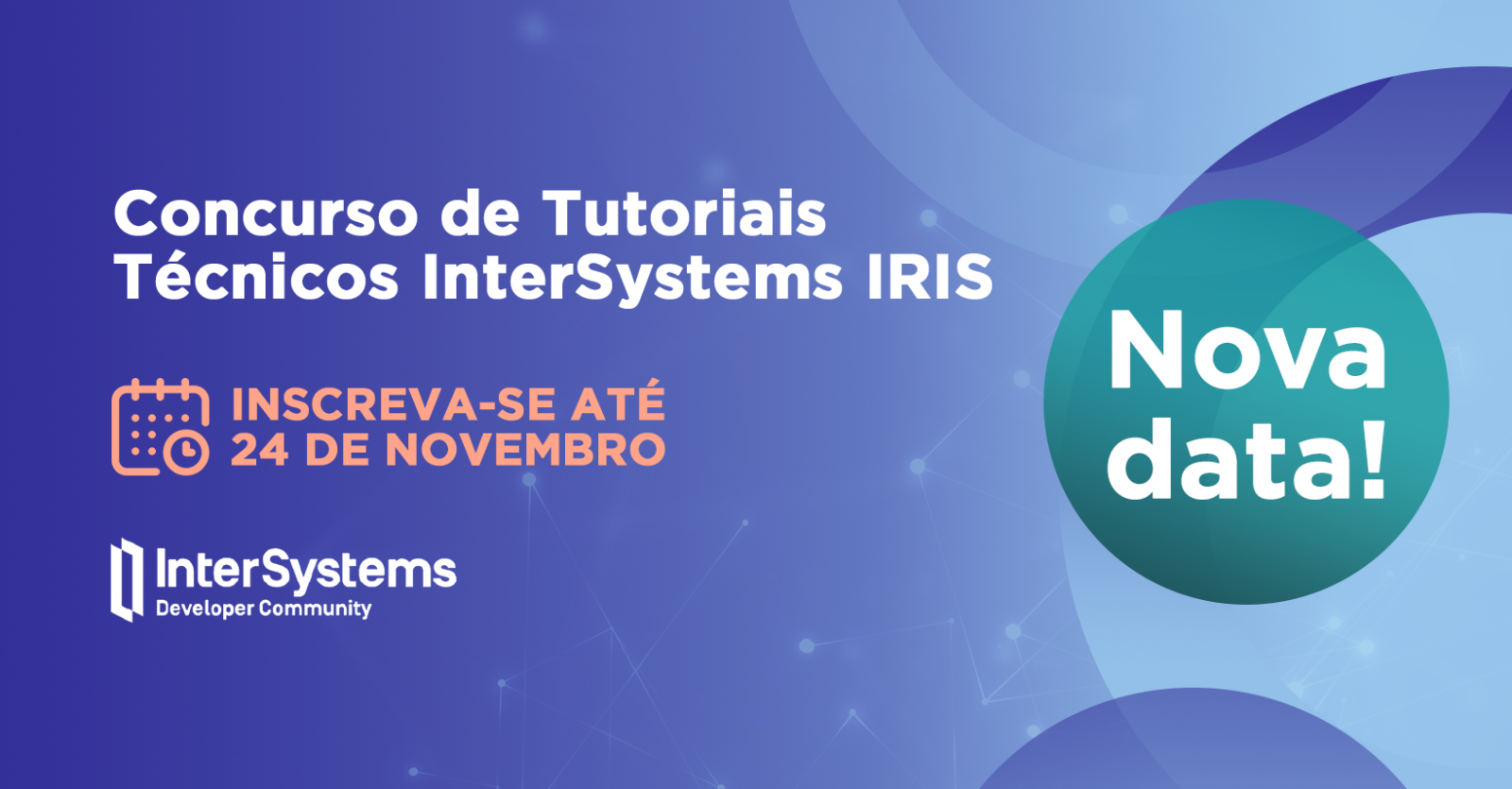Hola Comunidad,
¡Estamos emocionados de presentaros una nueva manera de mostrar vuestra creatividad y habilidades! Esta vez, os invitamos a participar en nuestro primer desafío de video:
📹 InterSystems Tech Video Challenge 📹
Enviad un video sobre cualquier tema relacionado con los productos o servicios de InterSystems IRIS del 21 de octubre al 10 de noviembre de 2024.
🎁 ¡Regalos para todos + opción a grandes premios!
.jpg)
🔍 ¿Cuál es el reto?
Cread un video corto (de hasta 15 minutos) demostrando un uso único de la tecnología de InterSystems. Ya sea una solución innovadora, un proyecto creativo o un caso de uso interesante, ¡queremos verlo todo!
📢 Cómo entrar
Para participar, tenéis que rellenar el formulario donde se os pedirá subir vuestro video. Después de que lo subamos al canal de YouTube de Developer Community, publicaremos el enlace en los comentarios de esta publicación para que lo podáis usar en cualquier lugar.
Quién puede participar: Cualquier miembro de la Comunidad de Desarrolladores, excepto los empleados de InterSystems (personal de empresas contratadas por InterSystems estáis invitados a participar). ¡Cread una cuenta!
Requerimientos generales
- El video debe centrarse en los productos o servicios de InterSystems y ser de carácter técnico.
- Todo el contenido debe estar en inglés (incluido el código, capturas de pantalla, etc.).
- Los videos deben ser 100 % originales y no pueden ser traducciones de videos previamente enviados para concursos en ninguna comunidad.
- Toda la información presentada debe ser precisa y confiable.
- Los videos deben tener una duración inferior a 15 minutos.
- Autores diferentes pueden enviar videos sobre el mismo tema con ejemplos distintos.
Nota: Nuestro panel de expertos tomará la decisión final sobre si un video califica para el concurso, basándose en criterios como la calidad y la relevancia. Su decisión es definitiva y no se puede apelar
Fechas clave del concurso
📝 Del 21 de octubre al 10 de noviembre: cread un video y rellenad el formulario durante este período. Los miembros de la Comunidad pueden votar por los videos publicados con "Me gusta": los votos en la Comunidad se premiarán
📝 Del 11 al 17 de noviembre: tiempo de votación de los expertos
📝 18 de noviembre: anuncio de los ganadores
Premios
1. ¡Todos ganan! Todos los participantes recibirán un regalo especial:
🎁 Gorra perforada Nike Golf Dri-FIT Swoosh.
2. Premios de Expertos: los videos serán evaluados por los expertos de InterSystems
🥇 1er lugar: iPad de 10.9 pulgadas Wi-Fi 64GB / Auriculares inalámbricos Sony WH-1000XM5
🥈 2º lugar: Mochila Moleskine Vertical para dispositivos - 15" // Sistema de lanzamiento espacial LEGO NASA Artemis.
🥉 3er lugar: AirPods 4 con cancelación activa de ruido / LEGO Hogwarts™ Castle: El Gran Comedor.
Como alternativa, cualquier ganador puede elegir un premio de una categoría inferior a la suya.
3. Premio de la Comunidad de Desarrolladores: video con más "me gusta". El ganador tendrá la opción de elegir uno de los siguientes premios
🎁 AirPods 4 con cancelación activa de ruido / LEGO Hogwarts™ Castle: El Gran Comedor.
Nota: Los autores solo pueden ganar una vez por categoría (hasta un máximo de dos premios en total: uno del panel de expertos y uno de la comunidad). En caso de empate, el número de votos de los expertos se utilizará como criterio de desempate.
🎯 Bonus Extra
¡Aquí está la lista de bonificaciones adicionales para ayudaros a ganar el premio! Por favor, dad la bienvenida a:
| Bonus | Puntuación | Detalles |
|
Bonus por tema |
3 |
Elegid un tema de la lista de temas propuestos a continuación para obtener esta bonificación. |
|
Bonus por artículo |
3 |
Escribid un nuevo artículo explicativo para apoyar vuestro video y utilizad la etiqueta #Video en él. |
|
Bonus por aplicación |
5 |
Subid la aplicación de vuestro video a Open Exchange. |
|
Bonus por traducción |
2 | Traducid vuestro video a uno de los idiomas de nuestras comunidades regionales (ES, PT, JP, CN, FR) y subidlo utilizando el mismo formulario; mencionad en la descripción que se trata de una traducción y proporcionad un enlace de YouTube al original. |
|
Bonus por YouTube Shorts |
2 | Cread un YouTube Short para vuestro video (video vertical, de hasta 60 segundos). |
|
Bonus por LinkedIn |
1 |
Compartid el video en vuestro LinkedIn, mencionando que estáis participando en el Desafío Técnico de Videos de InterSystems y etiquetando la página de LinkedIn de la Comunidad de Desarrolladores. |
Temas propuestos
Aquí tenéis una lista de temas propuestos que os otorgarán bonificaciones adicionales para vuestro artículo:
✔️ Uso de AI / GenAI / RAG
✔️ Uso de Embedded Python in Interoperability
✔️ Uso de External Language Gateways (C#, Java, Python)
✔️ Uso de Data Fabric / Data Lake / Data Warehouse / Data Mesh
✔️ Uso de FHIR
✔️ Uso de REST
✔️ IKO common deployments
---
¡Preparaos para brillar e inspirar a otros con sus habilidades tecnológicas! Estamos ansiosos por ver lo que crearéis. ✨
Nota 1: Al participar en el concurso, aceptáis que vuestro video sea subido al canal de YouTube de la Comunidad de Desarrolladores.
Nota 2: La entrega de premios varía según el país y puede no ser posible para algunos de ellos. Se puede solicitar una lista de países con restricciones a @Liubka Zelenskaia.


.png)
.png)
.png)
.png)
.png)